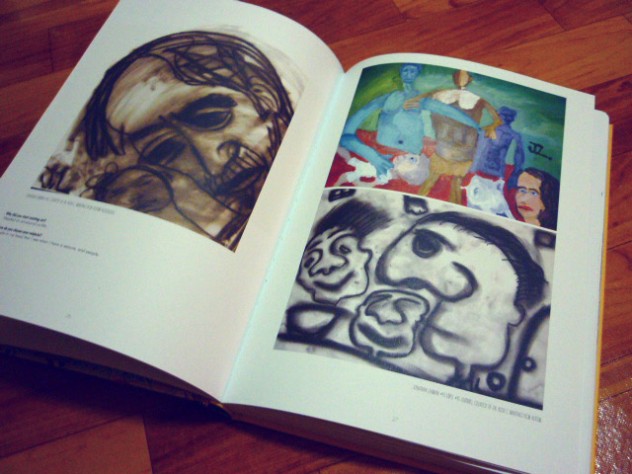 Weird Stuff
Weird Stuff  Weird Stuff
Weird Stuff  Animals
Animals 10 Inspiring Tales of Horses Being Human
 Mysteries
Mysteries Top 10 Haunting Facts About the Ghost Ship MV Alta
 History
History 10 Surprising Stories About the Texas Rangers
 Humans
Humans 10 Philosophers Who Were Driven Mad by Their Own Theories
 Miscellaneous
Miscellaneous 10 Video-Game-Worthy Weapons and Armors from History
 Weird Stuff
Weird Stuff 10 Psychics Who Accurately Predicted Wartime Events
 The Arts
The Arts 10 Pieces of Art Inspired by a Broken Heart
 Health
Health 10 Science Fiction-Sounding New Medical Treatments
 History
History 10 Surprising Facts About the Father of Submarine Warfare
 Weird Stuff
Weird Stuff 10 Times Real Laws Were Based on Bizarre Hypotheticals
 Animals
Animals 10 Inspiring Tales of Horses Being Human
 Mysteries
Mysteries Top 10 Haunting Facts About the Ghost Ship MV Alta
Who's Behind Listverse?

Jamie Frater
Head Editor
Jamie founded Listverse due to an insatiable desire to share fascinating, obscure, and bizarre facts. He has been a guest speaker on numerous national radio and television stations and is a five time published author.
More About Us History
History 10 Surprising Stories About the Texas Rangers
 Humans
Humans 10 Philosophers Who Were Driven Mad by Their Own Theories
 Miscellaneous
Miscellaneous 10 Video-Game-Worthy Weapons and Armors from History
 Weird Stuff
Weird Stuff 10 Psychics Who Accurately Predicted Wartime Events
 The Arts
The Arts 10 Pieces of Art Inspired by a Broken Heart
 Health
Health 10 Science Fiction-Sounding New Medical Treatments
 History
History 10 Surprising Facts About the Father of Submarine Warfare
10 Fascinating People With Savant Syndrome
Despite being one of the most fascinating conditions of the human mind, we still don’t know much about savant syndrome: a condition where a person displays an incredible gift in one specific area of intelligence, yet suffers from an often severe handicap in other areas. The fact that we used to call these extraordinary people “idiot savants” shows how little we understand the way our minds work.
Far from being idiots, people with savant syndrome are often extremely intelligent, even though that intelligence is focused on one or two specific areas. As one researcher put it, a savant’s mind is simply organized differently, with an “island of genius” amid the sea of a broader mental disability. Savant syndrome proves that the human mind is capable of far more than we give it credit for.
10 Tommy McHugh

For most of his life, Tommy McHugh was a con artist, criminal, and drug addict. But at the age of 51, something unexpected nearly killed him: he had a brain hemorrhage. With both sides of his brain bleeding, he underwent a tense surgery, and it was hours before anybody was sure he’d survive.
In the end, he made it, but with a strange side effect—he began to write poetry. It became compulsive for him. As he put it, “The more I wrote, the more I wanted to write, it was like a drug.” But soon, the drive to rhyme gave way to an even more bizarre obsession—for the next several years, McHugh spent nearly every waking moment painting. For up to 19 hours a day, he painted every surface in front of him.
When he couldn’t afford canvas, he painted the walls, ceiling, and floors of his home. According to a neuroscientist who has studied McHugh, the brain hemorrhage flooded his frontal lobe with blood, which is responsible for creativity. Somehow this switched off a natural inhibition that keeps this section from operating in the background of most people, leaving it on at full throttle constantly. McHugh has described what he sees as “endless, endless corridors.” When he paints, he’s capturing a snapshot of that mental picture.
9 Alonzo Clemons

When he was a child, Alonzo Clemons suffered a traumatic brain injury that left him with a permanent learning disability. Barely able to speak and with an estimated IQ of 40, Clemons didn’t have much to look forward to in life—until he began sculpting. At school, he would sit silently in the back of the classroom, molding bits of clay into tiny animals. When his teachers took the clay from him, he began scraping bits of pliable tar from the pavement around his school and working on sculptures in his room at night.
Alonzo is now considered one of the most talented sculptors on the planet. He creates incredibly realistic sculptures of animals—mostly horses, antelopes, and bulls—after seeing an image of one for only a few seconds. According to his mother, he can see an animal on TV and then complete a sculpture of that animal in half an hour. Even though he is unable to tie his shoes or eat on his own, it seems his mind somehow grasps the shapes and forms that he sees, and his hands become a flawless conduit through which he can reproduce those images. When asked how he does it, Alonzo will simply smile and point to his head.
8 James Henry Pullen

Often referred to as the “Genius of Earlswood Asylum,” James Pullen lived in England throughout the second half of the 1800’s and was committed to the asylum at the age of 15. Born with a mental disability, it was believed he was deaf and mute until the age of seven, when he learned to pronounce a single word: “mother.” He never learned to read or write, but he was remarkably talented at wood carving—especially ships.
His most famous work is a replica of the British steamship SS Great Eastern, which included such details as 5,585 individual rivets, and all the furniture inside the ship (which he carved by hand). All said and done, Pullen spent 60 years living at Earlswood Asylum.
7 George and Charles Finn

Calendar counting is an extremely difficult skill that allows a person to name the day of the week when given any date. For example, what day of the week was October 16, 1683? To George and Charles Finn, a pair of savant twins who are innately skilled at calendar counting, the answer would come as easily as remembering what they had for breakfast—which they can also tell you. For every day of their lives.
George and Charles Finn can name any date for 40,000 years into the past or future, which is longer than the calendar has even existed—maybe longer than it ever will.
6 Tony DeBlois

The average infant weighs about 3.4 kilograms (7.5 lbs) at birth. When Tony DeBlois prematurely entered the world in 1974, he barely tipped the scales, weighing in at 0.45 kilograms (0.99 lbs). He was barely breathing, so the doctors immediately put an oxygen mask on him. What they didn’t know at the time was that too much oxygen can make a person blind. And a few days later, that’s what happened to Tony. On top of the blindness and his slow physical growth, Tony DeBlois also had severe autism. But, at the age of two, he sat down at a piano and began picking out a tune.
From that moment, Tony began a progressive snowball into the world of music. Though he still struggles with his autism and is still blind, he’s learned to play over 20 musical instruments including the guitar, harmonica, trumpet, ukelele, harpsichord, mandolin, saxophone, and violin. It’s hard to pinpoint an exact figure, but it’s estimated that Tony has around 8,000 musical pieces memorized—all learned by ear, since he cannot read sheet music. According to his website, his attitude when approaching a new challenge is simple: “I haven’t learned that yet.”
5 Flo and Kay Lyman

Florence and Katherine Lyman are also twins who share the same remarkable ability. And oddly enough, they’re the only other known set of savant twins with the same calendar-counting talent. But Flo and Kay are remarkable even when compared in the amazing talent pool of savants. Not only are they twins, but they are also female—even more rare with autism.
Their calendar calculation skills fall in line with the Finn twins—they can name the day on which any date falls. If you ask them about a day from their own lives, they’ll tell you what the weather was like, what they ate, and everything they did in photographic detail. In particular, the twins have an encyclopedic knowledge of pop music from the sixties and seventies, as well as a fascination with Dick Clark—they can list every outfit he ever wore on the show $100,000 Pyramid.
4 Jason Padgett

Most people with savant syndrome were born with their ability. But Jason Padgett is believed to be the only person on the planet with his unique skill, and he didn’t receive it until he was 30. After being brutally mugged and repeatedly kicked in the head 12 years ago, Padget woke the next day to find his normal world overlaid with complex mathematical formulas. He saw them everywhere he looked, and so he began to draw the things he saw. Instead of numbers, these drawings took the form of vastly intricate fractal shapes and geometric patterns.
When neurologists scanned his brain, they found something incredible. Because part of his brain had been damaged, the brain was using other rarely used sections to compensate for the damaged part. By sheer dumb luck, the newly activated areas of his mind turned him into a mathematical genius.
3 Leslie Lemke

Leslie Lemke was born with brain damage, glaucoma that made him blind, and cerebral palsy. On top of everything, he was put up for adoption by his mother after six months. Eventually, he was adopted by a nurse who helped him through early childhood, during which he was largely unresponsive to external stimuli. He was able to speak fairly clearly until he was two and a half, but as his body deteriorated from the cerebral palsy, he lapsed into near-complete silence.
But at the age of seven, his life changed forever when his foster mother bought him a piano. Much like “Blind Tom” Wiggins, Lemke is typically silent and unemotional, but enters a state of rapture when he’s in front of a keyboard. In 1986, at the age of 34, Lemke underwent a full psychiatric evaluation, which determined that he suffered from “moderately severe mental retardation, atonic diplegia, scoliosis, and echolalia.” He was also at the learning level of a seven-year-old. Despite this, Leslie can play nearly a dozen instruments and can perfectly recall every musical piece he’s learned, including a 45-minute opera he heard on the radio and then played perfectly on his piano at home.
2 Jonathan Lerman

Literally translated, the word savant means “learned idiot,” which is just about the most inaccurate description imaginable for Jonathan Lerman, an autistic savant with an IQ over 150. Currently 26 years old, Lerman began drawing charcoal portraits when he was only 10. By the age of 14, his pieces were appearing in New York art galleries and selling for upwards of $1,200.
Lerman was a quiet infant, and by the age of two, his mother became so worried about him that she took him to the doctor, where he was diagnosed with autism. While the autism made it difficult to speak or communicate in most normal ways, his artistic ability allowed him to express himself through a visual medium. His artwork would be considered extraordinary even for a person with no developmental disabilities.
1 Tom Wiggins

We’ve all heard the story of how four-year-old Mozart listened to a song his father played and then replayed the piece perfectly on the piano. What most people don’t know is that, in 1862, a blind 13-year-old named Tom Wiggins was performing the same feat—but with two songs at a time.
Born a slave, Tom Wiggins’ abilities were soon discovered by his white masters, and they began touring him around the southern US. It’s estimated that Tom’s owner made about $18,000 off him per year. It wasn’t long before “Blind Tom” became a sensation. He had a remarkable ability to mimic nearly every sound he heard, and it was claimed that he could perfectly reproduce the sound of any animal. Tom could play a piece with his back to the piano and could play one song with his right hand, another song with his left, and sing a third at the same time.








